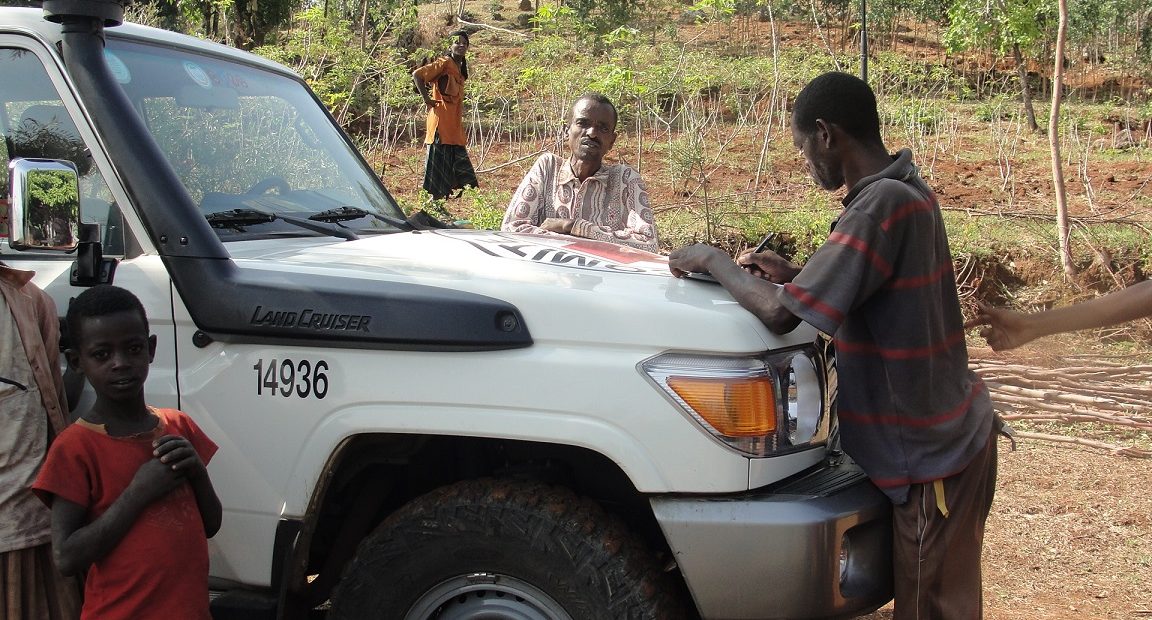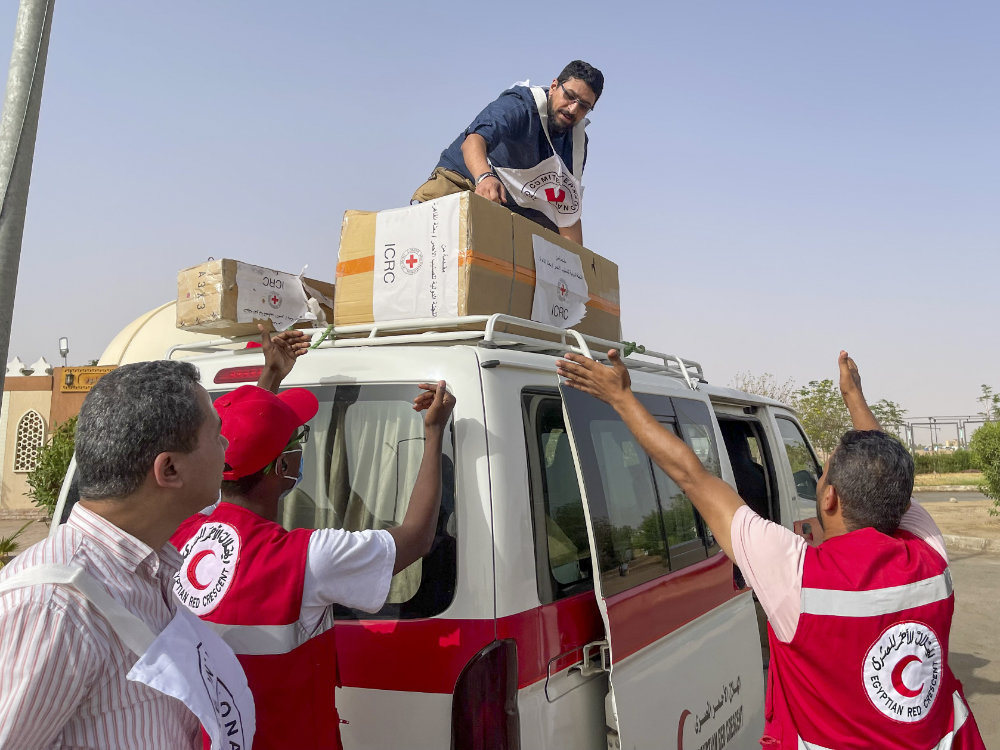There is now a general consensus that being accountable to people affected by conflict and their inclusion in programming is both a moral and ethical imperative for humanitarian actors and that it enhances the impact and relevance of the response. Humanitarian practitioners successfully approach the practice of accountability to affected people through the logic of a program cycle: involving communities in the assessment phase and respecting their wishes in the implementation phase leads to people-centric programming. Such approaches, however, as important as they are, hide many tensions and dilemmas inherent in humanitarian response, especially in conflict settings and protection interventions.
In this post, Indu Nepal, ICRC’s Deputy Head of Accountability to Affected People, and Natalie Klein-Kelly, ICRC’s Transformation Programme Manager for the Central Tracing Agency, share their reflections from putting accountability to affected people in practice and the dilemmas faced by humanitarian actors ahead of a larger discussion due to take place on 12th – 14th September 2023, People-centric humanitarian response in conflict: strategies, insights and dilemmas.
What does good performance on people-centric programming look like? Here are a few of the case studies we tend to share when asked for examples.
In a European country, the ICRC engaged with people displaced by an escalation of armed conflict to ensure that our response was relevant to their needs. Community members shared their observations, insights, recommendations and concerns during community discussions and through a dedicated hotline. Based on people’s recommendations, we adapted the program to provide cash assistance instead of in-kind services.
During discussions with the ICRC in Southeast Asia, displaced people who were staying in a settlement near the border expressed an urgent need for clothes. They recommended that the clothes should not be ready-made or monocoloured, noting that garments previously provided by the ICRC were ill-fitting and looked like uniforms, which indirectly contributed to their stigmatization. The ICRC also collected feedback from pregnant women, people with disabilities and young women who were unable to visit tailor shops to have their measurements taken. To prevent tensions between displaced people and host communities, the ICRC addressed the displaced community’s request by giving them vouchers that they could use at local businesses owned by the host communities. The vouchers allowed people to make purchases appropriate to their needs.
In a Middle Eastern country, an assessment was conducted to measure the inclusion of women in ICRC programs after the data collected by a feedback mechanism showed that a low proportion of women contacted the ICRC. The assessment revealed gaps in female representation in some programs, caused mainly by social barriers and selection criteria, as well as the ICRC’s support to traditionally male-dominated occupations. The results helped the ICRC to identify measures needed to enhance women’s representation in relevant programs.
A pattern begins to emerge: you ask a community about their needs, validate the findings, provide assistance or make a different intervention, ask for feedback, adapt your programming and go back to validate it again. This clean snapshot observes humanitarian actors and their interaction with a certain group of people, regarded as “the community” to be served, in one specific geographic area, during a specific point in time, and through a lens of one or more programmatic interventions.
The reality of people-centric programming is less straightforward. To fulfil the ethical and moral promise of accountability, protection actors like the ICRC and humanitarian practitioners need to grapple with the complexity of communities and their members, straddle different contexts and situations, and navigate tensions and dilemmas that require considerations beyond the project cycle. This has at least five implications for how actors need to support (and maybe also select) their staff, not only limited to their technical and programmatic skill sets.
1. The most important accountability and inclusion issues aren’t the ones about humanitarian processes or project cycles. They are about access to people, and that can be political.
Commenting on sector-wide performance with regard to Accountability to Affected Populations (AAP), the 2022 State of Humanitarian System report states that “while there are a number of initiatives and approaches that show potential, they have not yet delivered greater accountability or participation”. Among the reasons attributed to this lack of results was access to communities due to “conflict-related restrictions”.
Within the ICRC, this is also the issue we hear the most about from our colleagues. How can we integrate accountability to affected people in our work when we don’t have access to visit the community we want to work with as often and as freely as needed? To mitigate this, we have become more intentional about working with National Societies, community-based organizations, and contractors where it is possible to do so. We have gotten better at setting up virtual community engagement channels like hotlines, social media, SMS, etc. But access issues go hand in hand with deeper complexities.
Access is not only necessary for measuring programmatic results, like whether we reached the right people or if they received what they were supposed to. If that were the case, the humanitarian system would merely be a well-oiled supply chain. Access is imperative to understanding the “situation, and to be there and listen to the needs of the affected population”. “[A]ccess is needed for living and expressing the ‘humane’ and ‘altruistic impulse’ that is part of what defines humanitarian action”, to establish trust so affected communities can fully express their concerns. This is especially relevant for protection actors working with the community to identify and respond to protection threats.
Humanitarian access to communities in conflict is under constant scrutiny. A large proportion of the population is excluded from public life in contexts like Afghanistan and Yemen. Humanitarians are cut off from accessing communities that happen to live in areas controlled by opposition armed actors, others are cut off for raising protection concerns. Humanitarians may face myriad additional constraints linked to their own security and duty of care towards their staff, as well as that of the communities and individual persons with whom they engage. Even capacity and logistical constraints may have political dimensions in the way they can be linked to funding and donors. Political decisions and trade-offs will always challenge the ability of humanitarian actors – and of the individual staff member engaging a community – to provide opportunities for participation and inclusion.
2. The demand for evidence of community engagement has over-emphasized quantifiable markers, processes, and documentation, and has chipped away at the spirit of people-centric programming.
Partly to respond to the chorus of “we already engage with communities” and partly due to donor demand, accountability experts have spent much of the last decade trying to figure out how to demonstrate and quantify the impact of community engagement (or lack thereof). An obvious area of success is the deployment of systematic feedback collection mechanisms (i.e., processes to collect, document, analyse and respond to feedback), which now feel ubiquitous, including for the ICRC. Eighty percent of our operational delegations have documented approaches to the collection and use of feedback, compared to only a handful six years ago. We have tools to quantify perception and trust, which have been valuable in getting our colleagues in the habit of going beyond financial markers and validating their assumptions with direct feedback from the community members.
On their own, though, are these tools enough? Is there a danger of idolising them as the ultimate solution? What about the “costs”? The production of such evidence has created new processes and reporting requirements internally in humanitarian organizations. This has also created a hierarchy for what counts as valid evidence worth acting upon. We need statistically rigorous methodologies and sufficient sample sizes to prove what feedback is worth acting upon. We need compelling – and sometimes complicated – dashboards to help management decide on the right course of action.
People-centric programming is built on relationships – individual, contextual, and malleable – with the people affected by violence and other crises, and what really counts may not always be measurable with such approaches. Being people-centric is also achieved by ensuring we have staff who have the capacity for such engagement, as well as the right number of staff since speaking with individuals takes time. This is also a matter of personal ethics and mindset, as you need staff who are interested in continually questioning whether they are speaking to the right people, if they are missing someone if they could increase participation in difficult contexts, or if they are using what they heard in their programming and continually adapting. It needs people who are genuinely engaged, interested, capable, and compassionate.
We can build checks and balances for all kinds of accountability, as we do through our processes and reporting requirements, but we need to balance this with care and attention to the quality of the human interaction itself. Those with the best evidence may not always be the best programmes.
3. The measure of good performance on accountability in protection work isn’t just on the programmatic outcomes, but equally on the quality of the human connection at every touchpoint.
What are the limits to “listening to affected communities” for protection actors where they are unable to provide the main request of civilians living in conflict: physical safety? The responsibility for reducing human suffering amidst war and violence lies primarily with states and other duty bearers, based on their obligations under international humanitarian law (IHL) and other relevant law. Hence, for the ICRC, people-centric work is only one part of the equation.
Even when the work is people-centric, the ability to provide a positive outcome to any activity aimed at responding to risks and consequences of violence depends on many actors and variables and can be in constant flux. The dilemmas here are multiple, and some are well-known: the “well-fed dead” dilemma[1]; the appropriateness of engaging people in programme cycle questions, ultimately also self-serving for the humanitarian actor, when they may be facing far larger issues. The humble admission that a humanitarian actor on the ground may not be accountable for anything beyond how the community is engaged is a moment of human connection that can count more than any outcome.
There is also a question of who can actually be accountable for what, in view of a certain “division of labour” implying that affected persons may be encountering different staff members from humanitarian actors at different times to access one service. Accountability toward the affected person needs augmenting with accountability between staff members for the ultimate result. For example, within the cross-border family tracing activities of the Red Cross Red Crescent Movement, the Movement actor who engages a separated family member may have to rely on a National Society or ICRC delegation in a different country for results in solving the case and finding the missing family member. Here, one entity may be accountable for transmitting the request (and any results) and for how the family member is engaged, but not for the final result. The accountability for the final result is a joint accountability of many staff members from different entities of the Red Cross Red Crescent Movement’s Family Links Network, ICRC delegations and National Societies.
4. True application of accountability to affected people and inclusive programming approaches requires us to take a critical look at the composition of the community whose members don’t always work in each other’s best interests.
People are a part of communities, but they are also individuals, living in micro spaces and niches and the intersection of multiple populations. Even within what is defined as a community, members may have different and opposing perspectives and interests. This multiplicity underscores the need for our action to take into account the lived experience of people right down to the individual level.
Many of the ICRC’s protection activities, such as the protecting family links programs, are tailored to individuals. These engagements take the form of personalized interactions rather than community-wide initiatives. Consequently, our approach to accountability must reflect this granularity. It’s not simply about placing “people at the centre”, but rather each unique “person at the centre”. It’s in these individual interactions that we can truly value the unique experiences and needs of each person. This approach acknowledges that each person’s journey is unique, and understanding their situation is crucial.
A “community approach” can get in the way of this – for example when communities’ “negative agency” turns against its members or other individuals, “where communities have demanded violence against individuals considered to be a threat to the social order”,[2] or when a community’s acceptance determines whether a particular person deserves protection or not. Recognizing the humanity of every single person, regardless of the community they belong to, enables organizations like the ICRC to offer its services to individuals shunned by their communities – potentially for good reasons – or those who are members of shunned communities.[3]
5. People-centric work is a complex interplay between personal ethics, organizational values, and operational necessity that needs to be accounted for in recruitment, training, retention, and performance management models.
Every individual has personal biases and can be subjected to different kinds of pressure. Humanitarian actors accept that international staff can bring operational and strategic advantages by exercising neutrality during conflict, but pay less attention to biases that can undermine impartial action – identifying and meeting the needs of those who need it the most. For example, in the context of the family tracing work that the Red Cross Red Crescent Movement does, western international staff may think in terms of a western nuclear family, suggesting exclusive accountability towards the (biological) parent. They may react with irritation if other community members become involved, while this may be not only perfectly acceptable but actually necessary from the perspective of certain communities and their norms and customs.
Divisions between communities that are part of a conflict can be mirrored in the professional sphere. Being people-centric, as has been discussed above, is about relationships and trust. Being “local” is a key component of this trust – but what if trust is lost because the local identity of a staff member is not trustworthy to the engaged person? Division lines may run between communities that identify with parties to a conflict, but may also run within communities, for example on the grounds of gender. Can a male staff member, who is part of a community that may regard females as inferior, truly feel accountable to a female person of his own community? What are the implications for the women of this community who are willing to engage with him?
One could even ask whether concepts of accountability and a people-centric approach can clash with the values of certain communities[4]. In many contexts, our staff need to balance what the organization expects of them with what their families and communities expect of them. A tricky question that our colleagues often face is the idea of solidarity and nepotism[5]. In many contexts, community loyalty is a social safety net. For example, in Somalia, studies of how people survived the famines demonstrate that your chances are much better if you are from a larger, wealthier clan[6]. But in our western bureaucratic system – and in the ICRC’s code of conduct – directing contracts or aid supplies to one’s own extended family is considered nepotism at best, or straight-out corruption. The corresponding dilemma is that our staff (field officers, for example) gain power and influence with the community because of what they are able to bring to the community. To halt all favouritism risks disempowering our staff who can then perhaps no longer gain assurances for the safety of ICRC personnel and structures they were hired to secure.
Conclusion
Humanitarian actors measure their performance on quality and accountability using the logic of results-based (project) management, with a defined beginning and end. At the beginning stands an assessment that includes the voices of those to be engaged. Once the service is provided, the key indicator used is whether and to what extent the service user was satisfied with the quality, quantity, and timeliness of the service/assistance provided. This is accompanied by an assessment of the quality of the interaction, asking if the service user knew what they were entitled to, or knew how to make a complaint. To perform following this logic, we equip our staff to tick all these boxes (assess, implement, evaluate), to better manage resources in this process, demonstrate accountability for resources, and validate this from the perspective of the service user.
Being truly people-centric may need even more than this. There are many moral and ethical issues in complex contexts where the choices practitioners are grappling with go beyond the question of whether the provided service had the result they hoped. Larger questions of right and wrong may loom, or decisions needed between a “bad choice” and a “less bad choice”.
Developments and consequences cannot always be foreseen, and what may have been a “good service” as such can subsequently be rendered meaningless. The “well-fed dead” is only the most placative example of fluid nuances in usefulness and meaningfulness for the affected persons. In such a context, the question of accountability becomes one of “if the right action was taken at the right time in a specific situation and were all necessary components in place at this point in time to enable the action to be taken” and goes beyond the programmatic processes and evaluations we already have. It requires the right people with the appropriate skillset and values who can navigate the complexities of their contexts in the (ethically) right way. It requires us to engage with our staff and their skills, identities, and ethics; and to find alternative ways of evidence production.
[1] See, for example, the mention of this term in Roberta Cohen and Francis M. Deng, “Exodus Within
Borders: The Uprooted Who Never Left Home”, Foreign Affairs, Vol. 77, No. 4, 1998.
[2] “Just as communities’ positive agency is often overlooked by humanitarian organizations, so too is their negative agency, evident in conflicts ranging from Afghanistan and Colombia to Mali and Syria, where communities have demanded violence against individuals considered to be a threat to the social order, particularly criminals”. The Roots of Restraint in War, ICRC, December 2018.
[3] See discussions on neutrality in Massimo Lorenzi, Entretien avec Cornelio Sommaruga, Lausanne 1998, for example pp. 24-25.
[4] Doherty, J. From tick box to turning point: getting accountability right for improved humanitarian action, ALNAP, forthcoming.
[5] Thanks to Fiona Terry for sharing this example, which she will expand upon during the upcoming event entitled People-centric humanitarian response in conflict: strategies, insights and dilemmas.
[6] Nisar Majid, Guhad Adan, Khalif Abdirahman, Jeeyon Janet Kim, Daniel Maxwell, Narratives of Famine: Somalia 2011. Feinstein International Center, January 2016.
See also:
- David Loquercio, Martin Schüepp, “People, principles, and processes: accountability in humanitarian action”, August 29, 2023
- Colin Walch, “Supporting social protection: five considerations for a principled humanitarian approach”, June 8, 2023
- Pierrick Devidal, “‘Back to basics’ with a digital twist: humanitarian principles and dilemmas in the digital age”, February 2, 2023







Comments